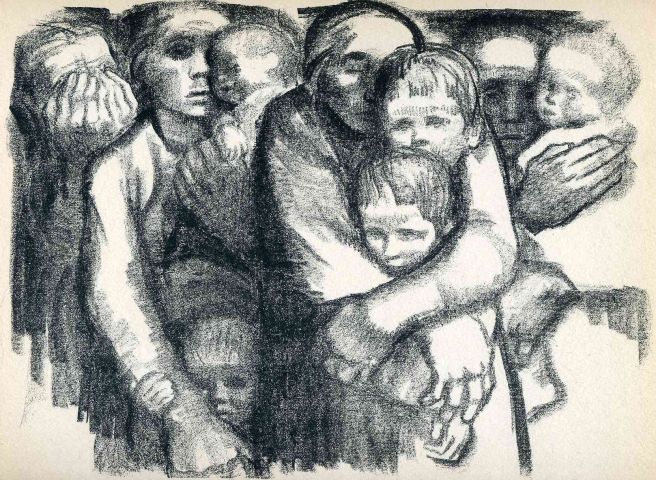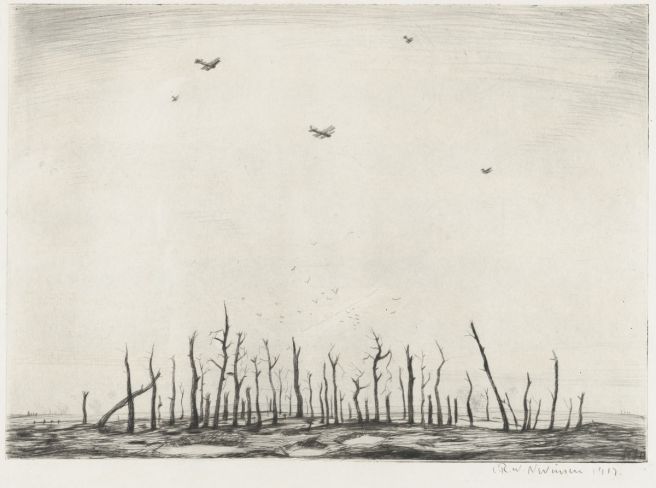When war broke out in August 1914, no one on either side of the conflict believed that it would rage on for over four bloody, devastating years. Many in fact, welcomed the war, believing it to be an opportunity for adventure —glorious and brief. The famous declaration that the whole thing would be finished ‘before the leaves fell from the trees’ or at the latest ‘by Christmas’ contributed to the romantic notion of going off to war. These fantasies were soon shattered by the gruesome reality of modern warfare.
The responses to the war evolved as time passed; from initial enthusiasm, nationalistic fervor and patriotism to shock, horror, anguish and remorse. These various and sometimes contradictory emotions are reflected in the art of the time. Photography and film news reels brought the carnage to life, so that even those at home got a taste of the true nature of war. Many artists and writers saw the war from the front lines and composed poetry, authored literature and created works of visual art reflective of those dreadful experiences. The following are samples of some of the works of art produced during and following The Great War:
I. At the outset, many believed that the war would bring an end to the old social and political systems and usher in a new order of equality and progress. This optimism can be seen in the following lithograph from a collection called, Mystical Images of War. The artist, Natalia Goncharova, a Russian living in Paris at the outbreak of war, depicts the angelic host watching over the soldiers as they march away.
The Christian Host ~ Natalia Goncharova, 1914

II. Paul Nash is one of my favorite artists and he’s been featured here previously. The painting Ypres Salient At Night heads my poem: Tales Of War. Despite the optimistic title, Paul Nash’s painting depicts a scarred landscape with shell-holes, mounds of earth, and leafless trees –the resulting devastation of World War One.
We Are Making a New World ~ Paul Nash; 1918

III. Kathe Kollwitz used her art to portray the grief of loss from war. The following two pieces show the heartbreaking agony and hardship experienced by those left behind.
Killed In Action (Gefallen) ~ Kathe Kollwitz, 1920

Mothers in different stages of life, held together by one common bond: the need to protect their children.
Mothers (Mütter) ~ Kathe Kollwitz, 1919

IV. Christopher Richard Wynn Nevinson revisits the desolation of No Man’s Land with insect-like planes buzzing overhead in That Cursed Wood, a title taken from a line in Siegfried Sassoon’s poem, At Carnoy: “Tomorrow we must go / To take some cursed wood… Oh world God made!”
That Cursed Wood ~ Christopher Richard Wynn Nevinson, 1917

V. I’ve featured Otto Dix twice before in my Great War posts. Shock Troops Advance Under Gas was the image for a post on chemical weapons and I used The Wounded Man to head my post about the disfiguring injuries to soldiers. You can click on the links to view those pieces. Otto Dix served for four years as a machine gun operator in the German army on the front lines in Belgium and France. He was grievously injured and suffered terrible nightmares about his experience. After the Armistice, during the height of these nightmares, he produced a series of drawings and etchings called The War (Der Krieg). Here is one more from that collection. In sharp contrast to the nationalist propaganda featuring war heroes like Baron Manfred von Richthofen (The Red Baron), Lens Being Bombed shows the terror and desperation of the citizens of the town in Northern France as they run for their lives.
Lens Being Bombed (Lens wird mit Bomben Belegt) ~Otto Dix, 1923-1924

There are many, many more significant artists and artwork to consider, so this will be one of several posts on the subject.



